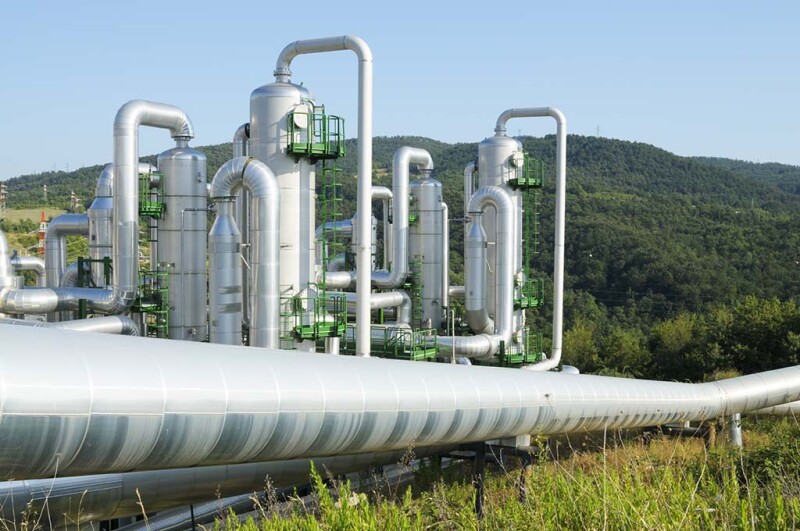What is the energy transition, and why should you care? As society is actively making goals to shift away from carbon-intensive processes—such as combusting coal and gas for power and heat-use production—a need for more clean and reliable power and heating/cooling production is emerging. Wind, solar, and other renewable energy sources can generate emission-free power for our grid, but these clean energy resources are intermittent in their supply and therefore cannot be solely relied on for a baseload (constant) supply of energy like coal and gas. Because of this, the industry should focus on utilizing conventional geothermal and industrial waste-heat to provide a baseload resource for reliable emission-free power and heating/cooling projects.
Conventional geothermal energy projects rely on drilling multiple miles into the earth (anywhere from 1 to 4 miles) where high-temperature geothermal brine (greater than 70°F) is produced to surface. The latent heat within this brine is then extracted and used to operate a power generation turbine or heating/cooling network. Then, the brine is reinjected back into the earth to be reheated for reuse, thus making the process renewable. Because there is a consistent 24/7 supply of geothermal heat for power production, a geothermal power plant produces a baseload and reliable supply of renewable electricity that can be sent to the grid or used “behind-the-fence” by a third-party. Similar to Alberta No. 1—Terrapin Geothermic’s geothermal energy project located in Alberta—conventional geothermal projects can also utilize the lower-grade heat that is left over after the power production process. Leftover heat can be supplied into a district geothermal heating/cooling network, where it provides baseload and reliable heating for processes such as passive greenhousing, crop drying, or any other heat-intensive process that normally combusts hydrocarbons as the heating feedstock. The network can also provide an emission-free offtake for excess hot or cool air from surrounding industrial processes, depending on the needs of the industrial facility.
There are many conventional geothermal heating/cooling-only network projects emerging. Here, the geothermal wells are drilled to a shallower depth and a cooler temperature brine than is needed for power generation is produced to surface to simply supply heat and offtake heating/cooling loads from surrounding infrastructure. The ability for conventional geothermal to produce both reliable power and heating/cooling is the major differentiator from other renewable forms of energy. This heat can be supplied up to 6 miles away from where it was produced from the subsurface, making conventional geothermal a valuable heating and cooling asset for nearby industries and communities looking to make the energy transition.
Conventional geothermal energy production is uniquely positioned to support the energy transition beyond renewable power and heating/cooling. Other “value-add industries” that geothermal can support include the generation of carbon offsets, lithium extraction (and other precious metals), green hydrogen production, and carbon capture utilization and storage (CCUS). More specifically, the emission-free power can be used to operate an electrolyser to produce green hydrogen; the geothermal brine that is produced to surface can be run through a mineral separator to harvest the concentrated lithium and other precious metals; and lastly, if the geothermal project is located within the range of a carbon-producing asset, like a gas turbine, the captured carbon can be injected into the subsurface through conventional geothermal wells for storage. Ultimately, whether it is generated power, direct heating/cooling use, CCUS, hydrogen, or precious metals production, conventional geothermal can play a large role in supporting many industries’ energy transition efforts.
A common question asked is why develop both conventional geothermal and industrial waste-heat recovery projects? Simply, both project types utilize the same core technology to convert its feedstock from heat to emission-free power: the organic Rankine cycle (ORC). The ORC is a binary-cycle process like steam power generation, and the production of power is tied to the temperature, flow rate, and uptime of the industrial waste- or geothermal-heat-producing asset. ORC projects can range in size from less than a megawatt to more than 20 megawatts of electricity. ORC technology is also industry agnostic and has been deployed within geothermal and various industrial waste-heat recovery applications such as oil and gas, steel/cement/glass/other heavy manufacturing, or other heat-intensive industries like pulp and paper.
Terrapin’s goal for recovering industrial waste heat is similar to developing geothermal power projects: capture the maximum amount of available heat possible and use that waste heat to produce baseload and emission-free energy. Once the power is produced, it can be used for sale into the local power grid; sold behind-the-fence back to the waste-heat producing facility; or sold to a co-locating, third-party offtake like a greenhouse or hydrogen producer. Like geothermal, waste-heat to power can support other industries requiring emission-free power and heat-use projects.
The last piece of the puzzle for how conventional geothermal and industrial waste-heat can support the energy transition comes down to the carbon offsets that these emission-free projects can produce. Conventional geothermal and industrial waste-heat projects produce Scope 2 emissions reduction credits, meaning that such projects can displace the use of grid power. A grid emissions intensity factor, or a carbon emission factor, is associated with each unit of electricity (kWh or MWh) provided by an electricity system operator, and it differs from state to state based on the total mix of hydrocarbon and renewable energy within the grid’s supply: a larger supply of hydrocarbon-based energy will result in a higher grid intensity factor, and a larger supply of renewable energy will result in a lower grid intensity factor. This grid intensity factor is used to determine the total amount of carbon credits conventional geothermal or industrial waste-heat to power project will generate. Additionally, the value-add industries (hydrogen/minerals/etc.) that are supported by emission-free energy can also generate carbon credits. In the US, there is currently no federal carbon tax that establishes a base price for the sale of a carbon offset, but there are voluntary markets that these carbon offset credits can be sold into, thus creating an additional revenue line item on a balance sheet.
So, why care about the energy transition? As global temperatures continue to rise, weather patterns become increasingly erratic, and environmental pressures escalate worldwide, our society is looking for reliable sources of clean energy to ensure that our industries and communities effectively transition to a net-zero future. The key to transitioning and meeting our carbon-neutral commitments lies in addressing the real need for reliable and emission-free power and heat to drive our growing economies. With their baseload capabilities, value-add industries, and carbon offset potential, conventional geothermal and industrial waste-heat recovery projects are well suited to fill that gap.
[The article was sourced from the author by TWA deputy editor-in-chief Stephen Forrester.]


